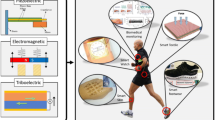Abstract
A contactless detector is presented for evaluating hand tremors caused by exercise-induced fatigue and early Parkinson’s disease. The device consists of a spiral coil, a microcontroller, and an inductive sensor circuitry. Theory shows that the resonant frequency of the circuitry increases when the distance between the hand and the spiral coil decreases, thus small variations of distance from tremor can be detected from the changes of resonant frequencies. A mechanical hand was built for experiments to simulate human hand tremors with repeatability at a fixed frequency. The magnitudes and frequencies of the tremors in the mechanical hand were quantitatively identified using the inductive sensor. Hence, feasibility and accuracy of the contactless hand tremor detector were determined. A triaxial accelerometer was used for comparison. By comparing spectral distributions and magnitudes of the tremors, the inductive sensor performed better than the accelerometer. The detector was applied to evaluate actual hand tremors of three subjects who had undergone exercise to induce tremors. The tremor waveform amplitudes of the subjects were quantitatively analyzed by the standard deviations method. The increased signal energies of exercise-induced tremor within 8–12 Hz were confirmed. Then, a subject with early Parkinson’s disease was evaluated by the proposed hand tremor detector. The tremor magnitudes and frequencies of the patient hand were quantitatively identified within in 4–7 Hz. Therefore, the new contactless hand tremor detector can be developed as a clinical instrument for monitoring the fatigue symptoms of post-exercise and diagnosing the early Parkinson’s disease.





















Similar content being viewed by others
References
Deuschl, G., Bain, P., & Brin, M. (1998). Consensus statement of the movement disorder society on tremor. Movement Disorders, 13(S3), 2–23.
Pierleoni, P., Palma, L., Belli, A., & Pernini, L. (2014). A real-time system to aid clinical classification and quantification of tremor in Parkinson’s disease. In 2014 IEEE-EMBS international conference on biomedical and health informatics (BHI) (pp. 113–116).
Morrison, S., Kavanagh, J., Obst, S. J., et al. (2005). The effects of unilateral muscle fatigue on bilateral physiological tremor. Experimental Brain Research, 167(4), 609–621.
Sirisena, D., & Williams, D. R. (2009). My hands shake: Classification and treatment of tremor. Australian Family Physician, 38(9), 678–683.
Anouti, A., & Koller, W. C. (1995). Tremor disorders. Diagnosis and management. Western Journal of Medicine, 162(6), 510–513.
Shi, W. Y., & Chiao, J. C. (2015). A contactless detector for tremors. In 2015 IEEE MTT-S 2015 international microwave workshop series on RF and wireless technologies for biomedical and healthcare applications (IMWS-BIO) (pp. 195–196).
Patel, S., Lorincz, K., Hughes, R., Huggins, N., Growdon, J., Standaert, D., et al. (2009). Monitoring motor fluctuations in patients with Parkinson’s disease using wearable sensors. IEEE Transactions on Information Technology in Biomedicine, 13(6), 864–873.
Su, Y., Allen, C. R., Geng, D., Burn, D., Brechany, U., Bell, G. D., et al. (2003). 3-D motion system (“data-gloves”): Application for Parkinson’s disease. IEEE Transactions on Instrumentation and Measurement, 52(3), 662–674.
Niazmand, K., Tonn, K., Kalaras, A., Fietzek, U. M., Mehrkens, J. H., & Lueth, T. C. (2011). Quantitative evaluation of Parkinson’s disease using sensor based smart glove. In 2011 24th international symposium on IEEE computer-based medical systems (CBMS) (pp. 1–8).
Jagiella, M., Fericean, S., & Dorneich, A. (2006). Progress and recent realizations of miniaturized inductive proximity sensors for automation. IEEE Sensors Journal, 6(6), 1734–1741.
Sakthivel, M., George, B., & Sivaprakasam, M. (2014). A new inductive proximity sensor based guiding tool to locate metal shrapnel during surgery. IEEE Transactions on Instrumentation and Measurement, 63(12), 2940–2949.
Beninato, A., Sinatra, V., Tosto, G., Castagna, M. E., Petralia, S., Conoci, S., et al. (2017). Inductive integrated biosensor with extended operative range for detection of magnetic beads for magnetic immunoassay. IEEE Transactions on Instrumentation and Measurement, 66(2), 348–359.
Schwan, H. P., & Foster, K. R. (1980). RF-field interactions with biological systems: Electrical properties and biophysical mechanisms. Proceedings of the IEEE, 68(1), 104–113.
Shi W. Y., & Chiao J. C. (2016). Contactless hand tremor detector based on an inductive sensor. In Circuits and systems conference (DCAS), 2016 IEEE Dallas (pp. 1–4).
Texas Instruments. (2015). LDC1000 inductance-to-digital converter, datasheet (Rev. B) [Online]. Available: http://www.ti.com/lit/ds/symlink/ldc1000.pdf.
Ding, S., & Yang, Y. (2012). Realization of numeral eddy current sensor modeling. In 2012 fifth international symposium on computational intelligence and design (ISCID) (vol. 1, pp. 527–530).
IEEE. (2000). IEEE guide for safety in AC substation grounding. IEEE. doi:10.1109/IEEESTD.2000.91902.
Schauber, M. J., Newman, S. A., Goodman, L. R., Suzuki, I. S., & Suzuki, M. (2008). Measurement of mutual inductance from the frequency dependence of impedance of AC coupled circuits using a digital dual-phase lock-in amplifier. American Journal of Physics, 76(2), 129–132.
Sample, A. P., Meyer, D. T., & Smith, J. R. (2011). Analysis, experimental results, and range adaptation of magnetically coupled resonators for wireless power transfer. IEEE Transactions on Industrial Electronics, 58(2), 544–554.
Jeon, H., Kim, S. K., Jeon, B., & Park, K. S. (2011). Distance estimation from acceleration for quantitative evaluation of Parkinson tremor. In 2011 annual international conference of the IEEE engineering in medicine and biology society, EMBC (pp. 393–396).
Author information
Authors and Affiliations
Corresponding author
Additional information
This manuscript is extended, as a special issue article, from the conference paper published in the IEEE Dallas Circuits and Systems Conference held on October 9–10, 2016.
Rights and permissions
About this article
Cite this article
Shi, W.Y., Chiao, JC. Contactless hand tremor detector based on an inductive sensor. Analog Integr Circ Sig Process 94, 395–403 (2018). https://doi.org/10.1007/s10470-017-1055-7
Received:
Revised:
Accepted:
Published:
Issue Date:
DOI: https://doi.org/10.1007/s10470-017-1055-7




